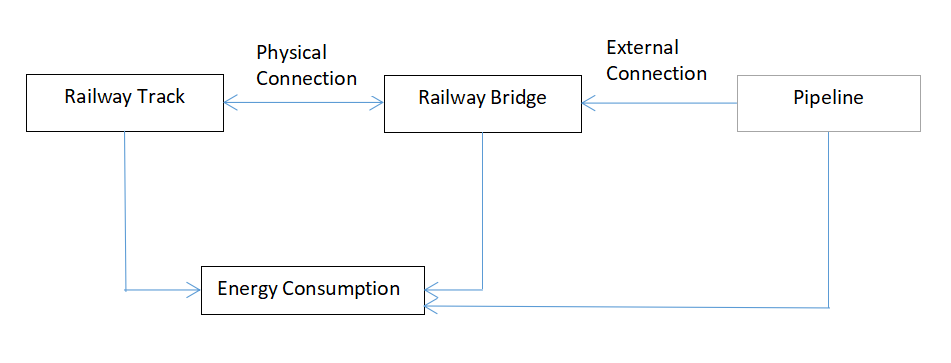The goal of this analysis is to evaluate the maintenance strategies and life cycles of a system that integrates the following individual systems:
- Bridge
- Railway tracks
- Water pipes
Each system can exist individually, though there are realistic scenarios where and engineer might consider them combined. For example, where a railway bridge already exists, and water pipes need to be laid across the same obstacle. From an engineering perspective it is interesting to look at the aspects that influence the systems between each other.
In this case, it can be stated that whilst the bridge can exist on its own, the other systems need the bridge but not necessarily each other. The water pipes and the railway tracks are therefore not codependent in terms of their individual functionality, but they influence each other and the bridge in terms of degradation, availability and maintenance.
Examples of these could be a flooding from broken water pipes, that leads to damage in the bridge and the railway tracks and might make the track unusable until repair; the pipes and the bridge could degrade faster due to vibrations from the running trains; maintenance work on one system might make another system unavailable for the duration of the works.
This analysis investigates different maintenance strategies, a Life-Cycle Analysis and a Multi-Criteria Optimization, aiming to help engineers tasked with the planning and maintaining such an integrated system.
The figure below shows the flow of the integrated system, declaring the energy and emissions of all individual steps for manufacturing and maintaining the systems are within bounds.
Fig1. Flow of Intergration
Civil systems for most of the time are designed to have service life as long as possible to save up on resources and labor cost. In order to construct such civil systems, the right materials and knowledge are needed to achieve it. The reason why an object gets worse over time is due to deterioration, and if a maintenance strategy is made to counter against the deterioration, a longer service life of the civil system will then be achieved.
Given this information, it is clear as day that the more maintenance we plan, the longer the system will hold. It is true, but if we bring cost into consideration, then it is no longer the best solution since the cost of the maintenance will be too high and it won’t be economical anymore.
Hence why a balance is needed to regulate the proper amount of maintenance needed for the system to ensure that it will achieve its expected lifetime while also being economical and less damaging towards the environment.
A life cycle analysis is performed as well to better understand what effect it has towards our ecosystem. Since we have limited resources and only one earth, it is important for us to sparingly use the limited resources and take the environment more into consideration. By performing LCA, we will be able to take sustainability into consideration as well during our decision making.
Content:
1. Scope & Integration Context of the Civil System
2. Integrated Maintenance Strategies
4. Multi-Objective Optimization
Downloads:
1. R-Script
